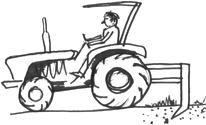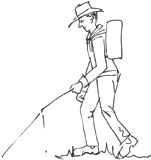| View Printable PDF |
Tree Planting Calendar For the Successful Grower
In order to have a successful tree planting / revegetation program you must be prepared well in advance of the planting day.
It has been proven over and over that weed or grass competition is the main cause of tree seedling mortality. In other words, the trees die before they become established because they are competing with the surrounding vegetation for available soil moisture. By keeping the area around the young tree seedling weed free, the seedling will grow without competition and by the first summer will have its roots into the moist subsoil helping it survive until the rains begin again.
In years of drought or exceptionally hot conditions this pre planting weed control could be the one factor between success and failure. Weed control is the most important step in a successful revegetation program.
The other points to consider now before you've picked your trees up and are ready to plant are:
1. Do you have rabbits or hares or other animals on your property that find tree and shrub seedlings tasty such as sheep, wallabies, kangaroos, crickets, magpies, etc?
If the answer is yes then you should be controlling the feral critters and fencing out the others. If you're not sure, look for burrows, droppings, or rabbit scratches in the soil. Go out at night with a spot light and look around for animals. You will soon see them in the light and you can work out what they are. Ask questions of your neighbours of their experiences- do they know of browsing animals in the area and if yes what are they?
2. What species of tree/shrub are you going to plant on your property? What are your needs/ wants?
a. Halting or slowing erosion.
b. Helping to curb a soil salinity problem.
c. Attracting birds and wildlife.
d. Windbreak or shelter for farm animals.
e. Screen out the nosey neighbours!
f. Firewood, sawlog or pulpwood supply.
3. When should you be planting your trees/shrubs?
a. Along our Southern coastline where frost is nonexistent you can start planting as soon as reliable autumn rains have saturated the soil and continue planting right up to spring (the difference in timing might be because of soil type, rainfall, protection from salt winds, etc).
b. Inland where soil can get waterlogged during the winter months or be prone to extreme frosts, an early to late spring planting is the recommended time. The soil is still moist (but starting to dry out) and is beginning to warm up encouraging the tree/shrub to grow. The seedlings' roots will follow the soil moisture down into the subsoil as the soil dries out from the surface down.
The Plan of Attack for Successful Revegetation
9-12 months prior to planting
1. Start your weed control program now if you have highly competitive weeds such as phalaris, blackberry, paspalum or bracken.
Grasses can be controlled with glyphosphate (ie Round Up) or by using mulch; woody weeds are controlled with Brush-off or more serious nasties like Garlon or even using stock like goats (they will also browse native plants you may wish to maintain so be careful. Goats only control blackberry, they won't kill it so as soon as you remove the goats, the blackberries will return-be ready!).
2. Order your plants well in advance of planting.
We recommend you order your plants before December (about 6-10 months before planting). If you don't know what to plant, give us a ring and we can help you with selecting species and where to plant them. Some species are difficult to grow or have certain seed collecting requirements. These plants need more time before they are ready for planting. It all boils down to being prepared.
3. Begin your vermin control program now!
The rabbit calici virus and mixomitosis have helped to control some of these critters but if rabbit burrows are still open, other rabbits will move in. Rabbit burrows need to be destroyed for long term control. Baiting, shooting, fereting all assist the task but in the long term you must remove their homes and harbour (ie bracken or blackberries). In large numbers, rabbits and hares will eat all of your trees/shrubs!
4. Wallabies and kangaroos can be a big headache locally so check with tree planting neighbours on their tactics or enquire with the relevant government agency.
4-6 months prior to planting 
1. If the ground has been cropped for years or has had cattle on it, the soil may be compacted which may affect root penetration of your native seedlings. Before the soil becomes saturated with autumn rains, pull a single tyne ripper through the soil using a tractor or dozer. Instead of slicing the soil, the ripper will shatter and crack the hardpan layer giving the trees' roots a chance to venture below the impeding layer. Single tyne rippers can be hired.
2. You will need to control weeds and grasses again when they germinate with the autumn break. This will either be with mulching or with chemical control (glyphosphate). Many people use a knapsack and spray spots with the herbicide where the tree will eventually be planted.
3. Mounding of the soil might be important if your plantation will be in a very wet or salty patch of land. After mounding, the winter rains will help break up any clods of soil in the mound where weeds (and their seeds) could be harbouring under. Special mounding implements can be hired.
4. Don't forget to get your fencing started (and hopefully completed). If you are using a fencing contractor, you'll need to have booked the contractor well in advance.
5. Do you need to order tree guards? Most guards only protect the plants from rabbits. Wallabies can't be guarded against unless using expensive wire mesh or tall tube guards. Wind can be limiting factor in extremely exposed areas however in most situations guards are not necessary against wind.
4 weeks prior to planting
1. If you're using herbicides to control weeds you should be spraying now. * If you sprayed glyphosphate in the autumn you have a choice now. You can just spray glyphosphate by itself (which will kill any weeds that have germinated since autumn) or you spray a mixture of glyphosphate and simazine (or other pre emergent herbicide). A pre emergent herbicide provides some post planting weed control by killing off germinating weed seeds. The success of this herbicide depends a lot on your soil type, rainfall near the time of application, and rate of application. (* Some landowners only apply herbicide once, 3-4 weeks before planting. This is usually the glyphosphate/simazine mix. This can be successful if the existing grass is short and doesn't have highly aggressive weeds like phalaris or kikuyu).
2. Fencing should be complete prior to planting. Stock should not run over the ground once simazine has been applied.
3. Contact Otway Greening to make sure all your plants are ready and arrange a pick up date.
4. What tools will you need to plant the trees/shrubs. You can hire Hamilton tree planters (for forestry tubes or Lannen cells); Potti Putki tube planters and kidney baskets (for Lannen cells) from Otway Greening. Organise them now!
Planting week
1. Pick up your order and give the plants a few days to get aclimatised to their new home. All our plants are grown out of doors so there will be no problems with the plants being too green.
2. If your plants are in cells (Lannen 81 or 63 trays) maintain a watering schedule. The seedling roots have claimed most of the space in the cells so the cells can dry out quickly especially on warm days. Make sure your plants are saturated for planting using a sprinker or wheelbarrow filled with water.
3. Have you organised family and friends to be labourers on the day? Work as a team with even the kids helping.
4. If the ground is wet (and your plants are too) it won't be necessary to water the plants in the ground. Just firm the soil in around the plants so there are no air pockets to dry out the seedling.
5. Make sure to have fun!
6. You might want to keep records of where and what you planted. This might be useful information later on when ordering more plants.
7. After planting, PLEASE return your Lannen trays to Otway Greening. They are very expensive to buy and we need to reuse them every year.
8. When returning your trays talk to us at Otway Greening about next year's project because it won't be long before the December deadline comes around.
Thanks to Janet Kitching for the illustrations! |










